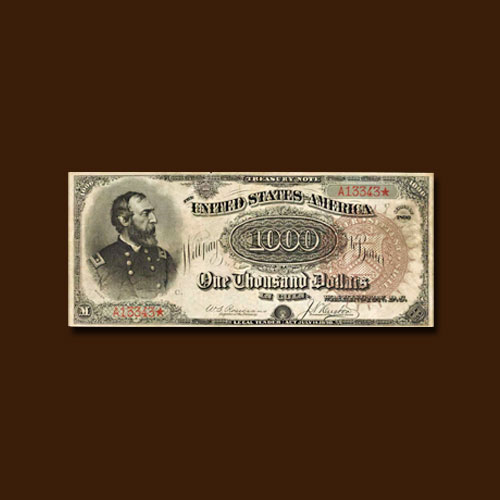Grand Watermelon Treasury Note
2020-02-20 Thu
Known as the "Holy Grail" of American Currency, Grand Watermelon is an 1890 Treasury note of the United States of America.While rare and outstanding notes abound in the Joel R. Anderson Collection, perhaps no single note has captivated United States currency collectors as much as this 1890 $1000 Treasury note, popularly known as the Grand Watermelon. These notes gained their famous nickname due to the distinctive large green zeros on the back of the note which resemble the fruit.
The type is known in two varieties with a large brown Treasury Seal and signatures of Rosecrans and Huston, and with a small red scalloped Treasury Seal and signatures of Rosecrans and Nebeker. The face design portrays Union Major General George Meade at left. Meade is best known as the victorious commander of Union forces at the Battle of Gettysburg. Near the center is an ornate 1000 die counter with floral ornaments.
The type ranks No. 1 in 100 Greatest American Currency Notes by Q. David Bowers and David M. Sundman. In the year 2018, the note was sold for the price of USD 2,040,000. No elite-level United States currency collection is complete without an example of this celebrated type.
Image Courtesy: auctions.stacksbowers.com
Latest News
-
Malwa Sultan Mahmud Shah Silver Coins
2025-09-11 ThuMalwa Sultan Mahmud Shah minted silver coins in round and square flans. <br><br> For round coins,...
-
Malwa Sultan Mahmud Shah Billon coin
2025-08-26 TueMalwa Sultan Mahmud Shah's billon coins followed three weight standards: 100 rati, 96 rati, and 80 r...
-
Fascinating Archaeological Facts on Postage Stamps - 91
2025-08-23 SatRhinoceros is one of the oldest land mammal species existing in India. There are five species of rhi...
-
Fascinating Archaeological Facts on Postage Stamps - 90
2025-08-23 SatUthiramerur, a Village in Kanchipuram, Tamil Nadu, is notable for its Temple inscriptions that descr...
-
Fascinating Archaeological Facts on Postage Stamps - 89
2025-08-21 ThuThe term “millet” is derived from the Latin word “milum,” which translates to grain. millets...

